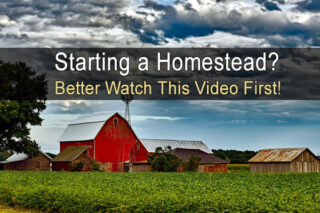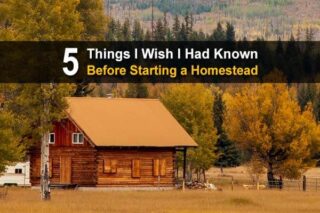Estimated reading time: 6 minutes
Making the move to live self-sufficiently, whether on a simple homestead or completely off the grid, is an exciting choice that more and more people are making. People are choosing this lifestyle to ensure their safety in the face of disasters, protect their freedoms, and enjoy a simpler life.
Homesteading can be incredibly rewarding. However, it is much more than what you may have seen on television. It takes dedication, a strong desire, and a good deal of effort to make it work.
Maintaining a homestead often requires long days, repairing tools, caring for livestock, tending to the garden and fields, fixing fences and buildings, and a myriad of other tasks. This is in addition to everyday tasks such as preparing meals, cleaning, and laundry.
Before plunging into the world of homesteading, there are a few things you should know. These tips will save time and frustration as you start out.
Want to save this post for later? Click Here to Pin It on Pinterest!
1. Planning is Essential
Planning every aspect of your homestead will help you chart a reasonable path toward your goals. This planning should include buildings, crops and livestock, as well as income producers. Grab a notebook or open your favorite notetaking app and dig in.
Start listing all the things you hope to accomplish on your homestead. Do you want to be completely off-grid? Do you want to produce 100 percent of the food you need each year? Do you need multiple income producers on your homestead?
Use this first list as a means to guide your research. Researching the best practices for areas outside of your expertise will enable you to make wise decisions in the planning phase of your new homestead. Reassess your list and start plotting out goals on a timeline. This will help you visualize the steps you need to take to stay on track and get your first year off to a great start.
2. Budgets are Critical
A large portion of the planning phase will involve setting a budget. When starting a new homestead, budgeting is critical to the success of the venture.
Creating a rough budget will allow you to easily prioritize projects you plan to complete each season. A detailed budget can then be made that lists household expenses, general homesteading expenses and major projects.
A key point to remember when budgeting is you must budget for items you will need to purchase for the household during those first few years on the homestead. As your land becomes more productive, a portion of this budget can be shifted to other areas, reinvested in the homestead, or even used to supplement emergency stockpiles and savings.
3. Location is Everything
While it is true that location is everything for building the perfect homestead, there are several ways to make imperfect lots of land into successful farms. When looking for available land, keep an open mind for the number of acres you need. The bare minimum is one-half acre for most homesteading ventures. Livestock can thrive and numerous crops can be produced on the right lot, no matter what the size.
If you are looking at going completely off-grid, search for land with at least two water sources. One well and one pond or stream should provide sufficient water for household use and for sustaining livestock.
4. Consider Downsizing Your Home
With the societal norm being a large house full of modern conveniences, planning a simpler and smaller home may seem like a drastic change. Smaller homes make it easier to regulate the temperature, which is particularly important if you are going off the grid. They also require less time to tidy up each day and don't have room for all the unnecessary items that accumulate in larger homes.
If your new land does not have an existing home, consider using an alternative dwelling. Today’s homesteaders have several choices for building on-site. Not limited to traditional buildings, owners are creating homes from prefabricated outbuildings, shipping containers, straw bales, and even using yurts as permanent dwellings.
5. Barns and Outbuildings
In addition to the primary dwelling, other outbuildings may be added as time and budget allows. Think past your immediate needs to ensure you will not outgrow your buildings too quickly.
Resist the temptation to throw quick buildings up, unless of course, you were formerly in construction or plan on hiring a crew. Hastily constructed barns, chicken coops, and other storage sheds can lead to loss of livestock and supplies as weather and predators alike will take advantage of flaws in design or construction.
6. First Plantings
It may seem counterintuitive but begin by planting perennials first. All the annual plants promise quick results, but letting perennials get established in the first year will allow you to reap the harvest from them much earlier. Fruit trees, berry bushes, asparagus, and many herbs take a few years to produce food for the table and for preserving.
Trees that will someday provide a windbreak, or perhaps even create a living fence, are best started early on. By planning ahead and planting trees, bushes, and other perennials first, you can potentially save money as well because it's cheaper to buy smaller starts and allow them to mature on your land instead of at the nursery.
7. Slow and Steady
We’ve all heard the phrase, “slow and steady wins the race,” and just like the tortoise, starting out slowly allows you to get established and not get overwhelmed. Starting out is exciting and it is tempting to begin work on every idea that comes your way, but getting caught up in this will only lead to burnout, wasted time, and lost money.
Slowly adding things to the farm–whether a new field, another income producer, a different type of livestock, or an alternative energy source–allows you time to evaluate and adjust your workload, your plans, and your goals.
Start where you are now. Learn skills that will benefit you on the homestead, even if you live in an urban setting that is restrictive. Make changes that reflect your changing values. This will allow you to smoothly transition to the homesteading lifestyle.
Like this post? Don't forget to Pin It on Pinterest!












Its really nice article. Thanks for sharing valuable information 🙂
I really enjoyed reading this article. Definitely going to use the list to start my garden this year. But there was the unfortunateness fo there being a menu that popped up for the website that took up half my screen making it a little annoying to read. Past that all well. Saving it to my Pinterest for sure!!